Samsung Galaxy S III specs review

Samsung pulled a bit of an Apple with the delivery of the Galaxy S III, we heard from many opinions when the phone launched last week. It upgraded the Galaxy S II just enough where it counts, compared to the competition, and focused on what you actually can do with the phone, introducing a number of unique interface and functionality improvements.
Nothing wrong with this strategy actually - the company has already blown our collective Android minds, and now it’s in it for the long haul. Last quarter Samsung made the record $5 billion profit, 73% of which came from the mobile division. Its main competitor - Apple - also saw mobile devices making the lion’s share of its $11 billion profit, so now the stakes are so high that, make no mistake, every feature that the Galaxy S III has or doesn’t have, had been carefully planned.
Design
Let’s start with the chassis - granted, it’s again plastic, but why aren’t we seeing phones with 4.5”+ screens made of metal, ceramic, or anything more premium than the polycarbonate on the Galaxy S III? Even HTC, which is fond of having the chassis crafted out of aluminum, went with polycarb for the 4.7” One X. The only exception we can think of is the 4.8" Pantech Vega Racer 2, which is ceramic, but comes bulkier than the Galaxy S III. Have a look at the video below, if you want a taste of how the S III might have felt like with a glass ceramic chassis.

The reasons for the choice of material are simple - polycarbonate is light, durable, allows for superior wireless signal penetration, and is uniformly colored inside and out, so when you scratch it, the mark remains with the same color.
Now the rounded shape of the Galaxy S III and the “Hyper Glaze” coat on the blue version are acquired tastes, but when you pry off that paper-thin back cover, you’ll find a swappable 2100mAh battery, and a microSD card slot. That’s more than we can say for any other flagship, be it the HTC One X, iPhone 4S, or the Sony Xperia S, and it was something we used to take for granted with Android phones just a few months ago. The micro SIM we’d probably have to stomach from now on, since the mobile phone makers are moving even further, to the nano-SIM standard, that is about to be approved very soon. Just go ask your carrier for one with an adapter to replace your regular SIM, if you are getting the device off-contract.
What’s more important is that the Galaxy S III is only a tad wider and almost as thin as the Galaxy S II, making it about as comfortable to reach with your thumb across the screen for one-handed operation, but it will still be a stretch if you have smaller hands. The bulk of the screen size difference - 4.3” vs 4.8” - has gone into the elongated profile of the S III, which we found pretty smart first time with the Xperia arc, and manufacturers have been warming up to the idea ever since.
Still, we’d like to see less bezel, but the addition of the home key at the bottom, which allegedly was thrown in at the last minute, might have warranted the current design. Management probably rightfully deduced that the Galaxy Nexus is an Android enthusiast device, and a poster phone for Android ICS, while Samsung plans to sell millions of Galaxy S IIIs to all kinds of people, so issuing a device with buttonless front was probably deemed a pointless risk in the heated debates.
Display
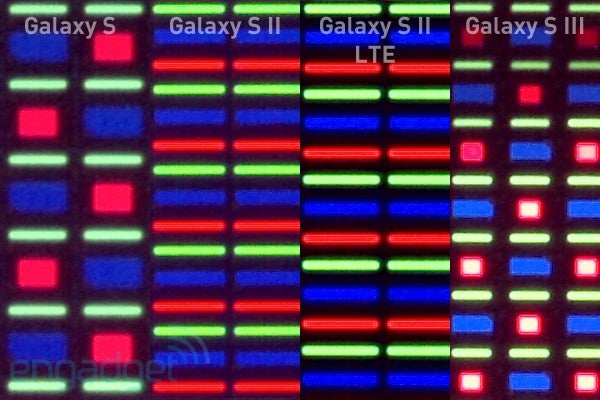
Speaking of the front, we can’t help but wonder why our dreams for an HD AMOLED display with traditional RGB matrix made with the Laser Induced Thermal Imaging (LITI) method, didn’t materialize with the Galaxy S III. After all, we saw the reports and research from reputable OLED industry organizations and analysts that Samsung has cracked the code for high pixel density AMOLEDs that use stripe, instead of PenTile matrices.
Yet we don’t know if the sole A2 Phase 3 line in the 5.5-Gen AMOLED plant of Samsung would have been able to churn out the millions of screens needed for the Galaxy S III this year. The alleged plan was for it to produce trial runs since Q3 last year, and start mass production with 32 thousand sheets capacity in Q2 this year, which is halfway through.
And let’s not forget that Samsung shattereed a football field worth of display glass until it figured out how to produce the high-definition Super AMOLED displays of the Nexus and the Note, so it’s not because Samsung is cheap. On the contrary, the LITI production method is way cheaper than the Fine Metal Mask (FMM) that Samsung is using for the 4.8” HD Super AMOLED screen on the Galaxy S III, but the scale of the technology might just not be there yet.
Oh, well, later on, we hope. In the meantime we won’t try to dissuade screen purists that the PenTile display on the Galaxy S III won’t look grainy compared to an RGB matrix one when put under a microscope, or solid colors examined from a very close distance. We have laid out our opinion that PenTile is just different than what we are accustomed to, and that’s all there is at this HD resolution, and from a normal viewing distance. You’d have to be really looking for PenTile up close to find PenTile, and 99% of people who will buy the phone, won’t be able to spot anything but a vivid display with infinite contrast and excellent viewing angles.
Moreover, the Samsung Galaxy S III seemingly has a new antireflective coating or layer applied, as it has shown excellent result in sunlight visibility tests, despite not being brighter than the Galaxy S II, for example, with about 330 nits brightness.
The S II has only about 6% reflectance, while recently the Nokia Lumia 900 was measured to sport the astonishing 4.4% with its ClearBlack AMOLED display, so we can only imagine that the Galaxy S III might show a similar extremely low reflectance ratio when measured professionally, which is important if you are going to use it in high ambient lighting, and at the same time is a passive way to improve on sunlight visibility without draining battery with higher brightness.
In fact, we just got an update that the new Samsung Omnia M features a 4" Super AMOLED with "reduced glare [that] lets you view messaging, multimedia and Web content in brilliant color and clarity—even in daylight conditions—while saving significant battery life", so that's what the Galaxy S III most likely also has on its screen.
Moreover, Samsung has now provided not three, but four screen modes, something exclusive for its handsets - the Dynamic, Movie and Standard ones we are used to from the Galaxy S II, as well as the new Normal mode, which addresses the complaints of screen purists that the standard AMOLED colors exceed the color gamut by a large margin, making them too “gaudy” for a calibration specialist, let’s say.
For us regular folks, the AMOLED feels like a candy store, but it’s great that a more toned down and calibrated mode is offered for people who are annoyed by oversaturated colors. We’d have to examine the new mode closer, though, before we deduce that’s what it is, but these color modes are something offered only on the Galaxy S III.
Whether this new Natural mode means that Samsung has experimented with different LED materials, like adding phosphorescent green, will probably become clear once the screen is really dissected by professionals. Red phosphorescent dye has been used in mobile phone screens since 2003, but green just started commercialization last year, and blue phosphorescence with the needed efficiency is such a recent phenomenon, that Samsung hasn’t probably been able to apply it yet.
The main advantage of phosphorescent dyes is their efficiency, which at normal brightness will mean power consumption of OLEDs comparable to LCD screens when displaying white, something that LCDs had an edge in. We’ll test this performance with the Galaxy S III and let you know.
Processor
Recently it turned out that it’s not one of the usual suspects Qualcomm, NVIDIA or Texas Instruments that is in the most dual-core smartphones, but actually Samsung’s ARM-based processors. That’s due to the fact that it not only makes the homebrew Exynos silicon for its own phones, but also supplies the Ax-branded chippery in Apple’s mobile devices.
The Galaxy S III everyday grind will be pushed by either the quad-core Exynos 4412, or the dual-core Qualcomm Snapdragon S4. They are made with the brand new 28/32nm production generation for mobile chipsets, meaning a significant leap in performance vs power consumption compared to the 40/45nm Cortex-A9 chips we had until now.
Why didn’t Samsung use the 2GHz dual-core Cortex-A15 Exynos 5250? Because it didn’t need to. It’s made for tablets, as Samsung kindly demonstrated to us at CES this year, powering a 2560x1560 pixels screen with its ARM Mali T-604 GPU. There is no point of scaling to put it in a phone, where nothing over the current 1280x720 pixels makes sense.
Samsung, for that matter, overclocked the Mali-400 GPU to 400MHz+, which the 32nm chip allows easily, and now the Galaxy S III beats everything in the graphics benchies, save for the quad-core PowerVR GPU in the new iPad, which, however, has to power the “Resolutionary” 9.7” screen, and will most likely be scaled down for the new iPhone, since, again, it makes no sense there.
The earliest we can see Cortex-A15 chips in phones or even tablets will be for the holidays, when maybe NVIDIA will try to be first just for the taste again, while mass usage of A15 chips in our mobile devices won’t happen until early next year at least.
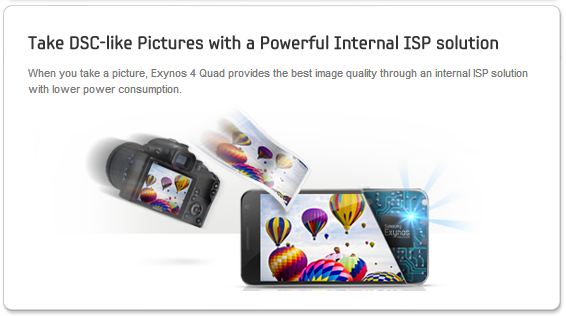
Both Exynos 4412 and Snapdragon S4 are now at the top of the Android benchmarking game, so your Galaxy S III won’t feel underpowered, no matter which one ends up in it. If your carrier has an LTE network up and running, you are likely to end up with Qualcomm’s MSM8960 chipset, which has the newest 28nm LTE radio integrated in it.
Samsung said it has dedicated engineering teams working on homemade LTE chips to embed with Exynos, but it’s just not there yet. It’s hard to beat Qualcomm in this game as of this moment, and that was vividly illustrated in the last quarterly, when it became clear the company has amassed $26 billion cash pile selling wireless chips, licenses and know-how in that realm.
The Texans are the best there is when it comes to integrating every band under the sun in a chip the size of your nail, testing, fine-tuning and producing it in the most compact and power-efficient form available. The TSMC foundry can’t even supply enough of those 28nm chips for Qualcomm and its customers, let alone someone else producing an LTE chip with the same capabilities, footprint and power envelope this year. It’s going to take longer for Samsung to do that, and the difference in production components price to use Exynos or S4 is likely just a few bucks, which doesn’t warrant using anything else with inferior LTE radio.
We can argue until we are blue in the face about the perceived advantages of quad-core vs dual- in parallel processes like browsing, gaming or video editing, but in reality the apps have to be particularly optimized for that, and maybe the only advantage of the Exynos will be in browsing. The Galaxy S III browser, however, seems to be so optimized and tweaked, that the handset blows every other Android in Java benchmarks out of the water with almost double scores, as you can see in the slideshow below, courtesy of Anandtech, which can hardly be achieved by just the two more cores of the Exynos.
We’ll know more when we test an AT&T, Verizon or Sprint Galaxy S III vs the international version, but even if there is a prevailing difference, its magnitude will more than likely be insufficient to warrant the incessant whining how the US will be stuck with the “inferior” dual-core. In everyday usage nobody but spec geeks will be able to tell a difference, and no company got rich and famous catering to that crowd. As a friend eloquently put it - “a few more points on Quadrant don’t get you laid” - so let’s move on, and be happy that no matter what we’ll have the best chips that the market can currently provide with the Galaxy S III.
As for power consumption and battery performance with one chip and network vs the others, that’s a whole different story that can be told only when we get all versions released and tested.
Camera
Samsung uses the same 8MP resolution for the camera on the Galaxy S III that is in the Galaxy S II, but not the same module. Just like HTC before it, Samsung is making a good use of the new Android ICS camera API with the 8MP module on the Galaxy S III. The camera on its newest flagship sports f/2.6 aperture, compared to the f/2.65 on the Galaxy S II, and the focal length has shrunk to 3.7mm from 3.97mm, allowing you to fit more scene in the frame.
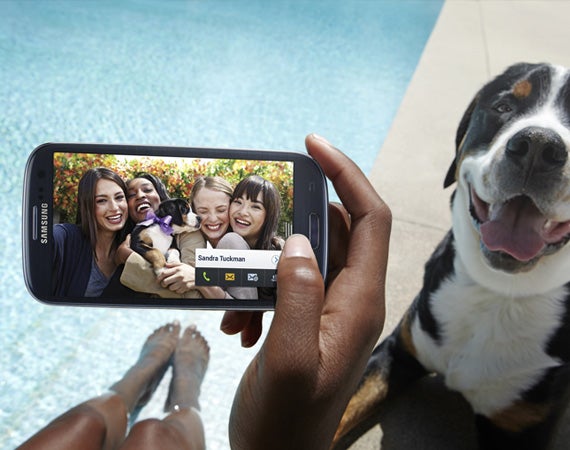
Galaxy S III can automatically tag friends and send the picture to them
The camera takes 6 pics a second, compared to the HTC One series 4 pics, but is restricted to 20 in total, taken in a tad over 3 seconds, Samsung said, so as not to fill up the storage with identical shots, whereas HTC allows up to 90 such burst mode photos taken in 22 seconds and change.
The 2MP front-facing camera records HD video, too, and features a back-illuminated sensor, so those midnight Skype video calls should look good.
A couple of photos and videos taken with the 8MP camera on a prototype model are already up, and the results are very pleasing for a non-final unit. Gone are the colder colors in the Galaxy S II - Samsung has learned its lesson, and has bumped up the saturation, which most of normal users prefer before realistic color representation - at the same time it has kept the noise in check, dynamic range great, and detail aplenty.
The real test will be in low light conditions, too, where most phones fail miserably, and we’ll be testing these abilities soon. The Galaxy S II fares incredibly well in low light, beating even the current flagships with the fancy sub-second cameras, so we expect nothing less from the S III. Have look at the samples below, courtesy of GSMArena.
The video is also smooth, with plenty of detail and pretty colors, recorded in MPEG-4 with 17Mbps bitrate and stereo sound. Well, it is certainly shaping to be one of the best phone cameras out there, so take a gander at the pictures and 1080p video samples from the Galaxy S III in the slideshow below:
Sensors and extras
Sensors are definitely put to good use throughout the "Natural Interaction" interface in the Galaxy S III. The new TouchWiz Nature UX is told by the proximity sensor that you’ve put the phone to your ear when reading or writing a message to somebody, and immediately calls them, without having to go through the hassle of searching or scrolling through the address book for that. That’s the Direct Call feature, and it works in the Contacts app too.
The front-facing camera now recognizes your eyes are looking at the phone’s screen, and prevents it from dimming or locking. Samsung introduced such eye-tracking feature in the ICS update for the Galaxy S II, requiring you to blink to use the Android 4.0 Face Unlock feature, thus preventing the picture-cheating phenomenon. In the Galaxy S III eye-tracking is taken to a whole new level, and called Smart Stay, but we are yet to test thoroughly how it works in the dark, for example.
This tracking also allows you to take a screenshot by just sweeping with the edge of your palm, as if scanning the page, another pretty cool feature. The palm can also pause music playback, again leveraging the motion sensing capabilities of the Galaxy S III.
S Voice uses the noise-canceling mics and natural language interpreter to allow easy interaction with the phone by voice, Siri-style, and gets us the ability to shout “Snooze” to the alarm and turn to the other side “just for 5 minutes”, for instance, and can also be used for dictation and web search.

Galaxy S III S Beam
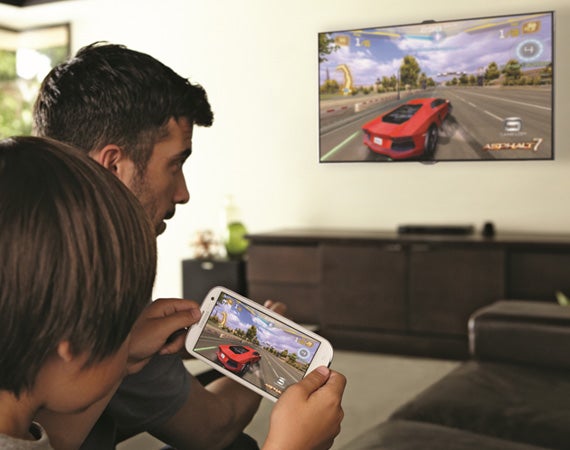
AllShare
The NFC chip will get a special treatment during the Olympics where the VISA-Samsung partnership will leverage mobile payments for the first time on a grand scale, while the whole world is watching.
Then we get to the accelerometer and gyro, which allow you to check for new messages/email or update news and weather by shaking the phone, and look for Bluetooth devices that way. Flipping the phone over will now turn off the ringer/alarm, but also cuts any media playback too. Tapping twice at the top gets you to the beginning of a list or website.
Finally, the touch sensor works in tandem with the accelerometer to get you straight into the camera interface when you hold a finger on the screen while turning the Galaxy S III in landscape mode. Take a look at some of the extras demoed in our slideshow below:
Call some of the above extras that come with the Galaxy S III gimmicks or not, but most of them are unique to the phone, and it’s their aggregate usefulness that makes the handset stand out.
Conclusion
Granted, the Galaxy S III design is bland compared to what we expected, but it delivers on every other spec front, save for maybe the screen matrix tech and the ARM Cortex generation, again compared to our collective wishful thinking. PenTile vs RGB and dual- vs quad-core or Cortex A9 vs A15 are such abstract notions for the average user, though, and affect so little of their everyday experience with the phone, that we should probably put the geeky concerns to sleep already.
Samsung now has Apple-level mojo in the Android world for customers, so no wonder its flagship is not a year ahead of its times in specs, as we tech bloggers wished and clamored for, it doesn’t need to do that. After all it is still going to be a “wow” for newcomers, and a huge jump for those upgrading from a Galaxy S, whose contract is about to expire.
As for the looks and shape, Samsung could have indeed done something more, yet we all know that just like with a new girlfriend, in a few weeks/months you’ll stop noticing or parading the design of a new phone as much, but will have to live with the character and whether you fit for quite longer. In that line of thought, the Samsung Galaxy S III top-shelf specs are coupled with unique abilities and expandable storage plus removable battery, not to mention that the ROM modding gang will soon be all over it like flies on maple syrup, so it sounds like a keeper. We’ll let you know for sure in our upcoming (p)review.

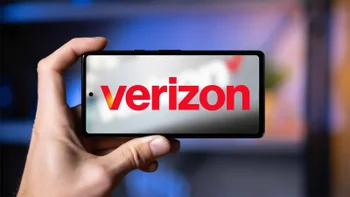

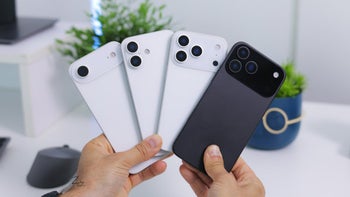
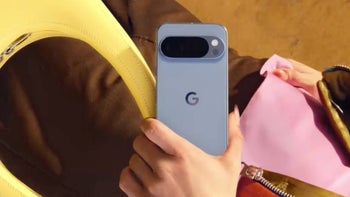

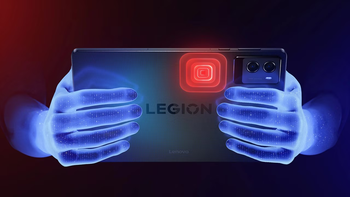
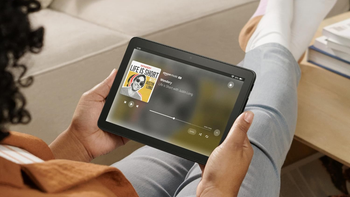


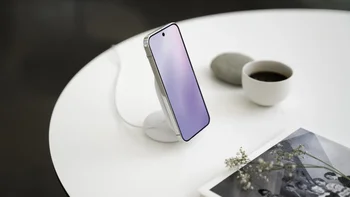

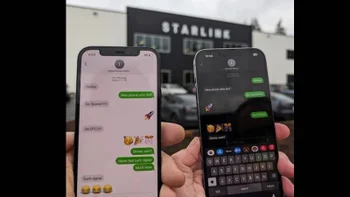
Things that are NOT allowed:
To help keep our community safe and free from spam, we apply temporary limits to newly created accounts: